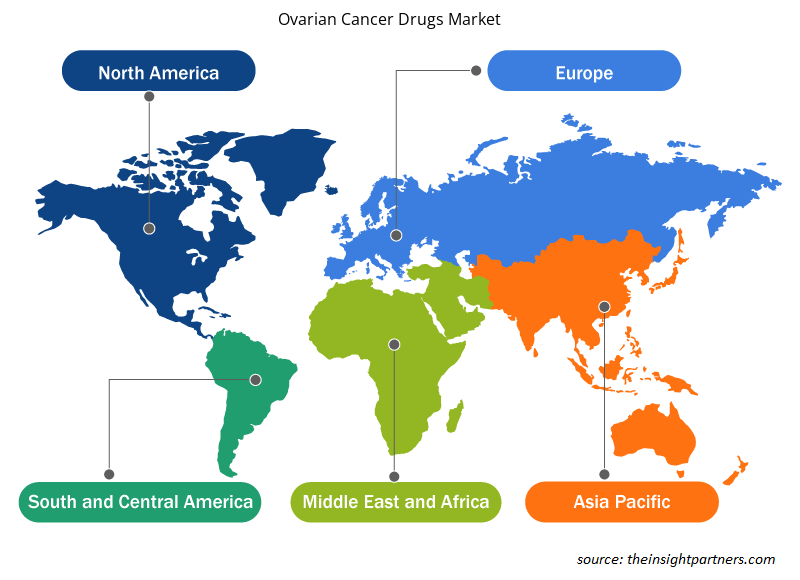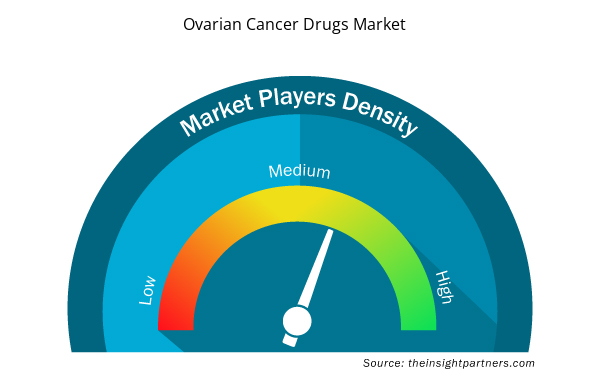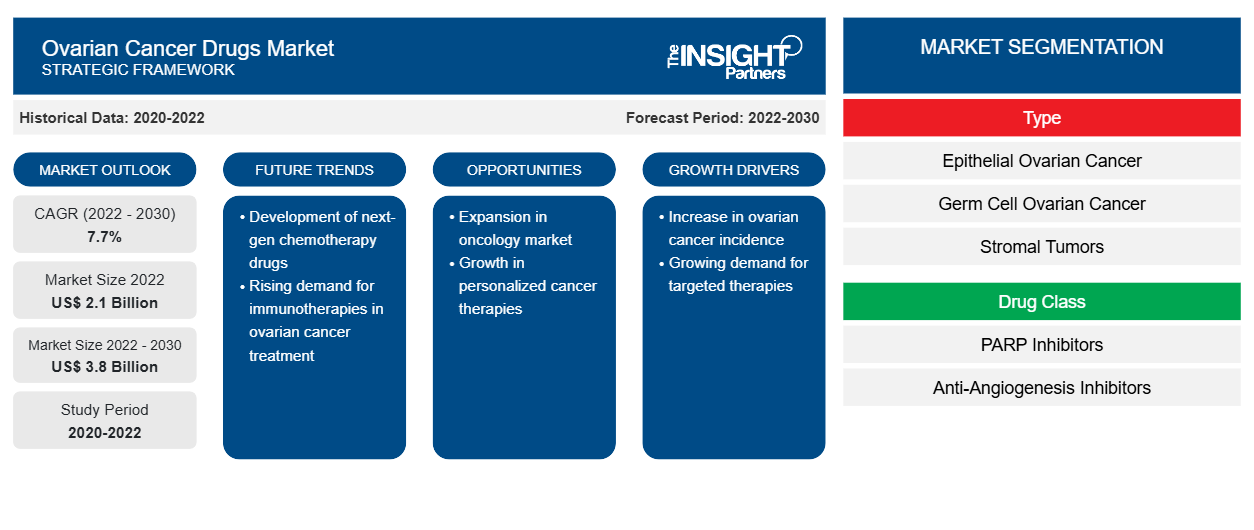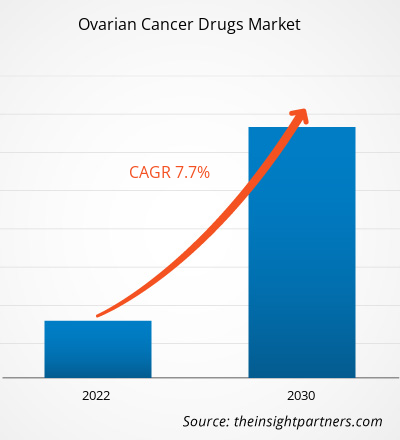[Forschungsbericht] Der Markt für Medikamente gegen Eierstockkrebs soll von 2,1 Milliarden US-Dollar im Jahr 2022 auf 3,8 Milliarden US-Dollar im Jahr 2030 wachsen; für den Zeitraum 2022–2030 wird eine durchschnittliche jährliche Wachstumsrate (CAGR) von 7,7 % erwartet.
Markteinblicke und Analystenansichten:
Die steigende Zahl an Eierstockkrebserkrankungen treibt das Wachstum des Marktes für Medikamente gegen Eierstockkrebs voran . Produktrückrufe aufgrund von Nebenwirkungen behindern jedoch das Marktwachstum.
Wachstumstreiber:
Steigende Fälle von Eierstockkrebs erhöhen die Nachfrage nach Therapieoptionen
Eierstockkrebs ist die siebthäufigste Krebserkrankung bei Frauen und die dritthäufigste gynäkologische bösartige Erkrankung nach Gebärmutterhalskrebs und Endometriumkarzinom (Gebärmutterkrebs). Dem Bericht der World Ovarian Cancer Coalition zufolge werden jährlich 324.000 Frauen mit Eierstockkrebs diagnostiziert, und 207.000 Frauen sterben an der Krankheit. Darüber hinaus wird bei der Mehrheit der Patientinnen mit Eierstockkrebs ein fortgeschrittenes Stadium (lokal fortgeschritten oder metastasiert) diagnostiziert, da es kein öffentliches Gesundheitsscreening-Programm zur Früherkennung von Eierstockkrebs gibt. Daher treibt die steigende Inzidenz von Eierstockkrebs die Nachfrage nach effektiven Therapieoptionen voran. Die Erstlinientherapie mit einer Kombination aus Debulking-Operation und Chemotherapie auf Platinbasis ist die Standardbehandlung für Frauen mit kürzlich diagnostiziertem fortgeschrittenem Eierstockkrebs. Darüber hinaus sind Therapieoptionen wie die zugelassenen PARP-Inhibitoren Olaparib, Rucaparib und Niraparib bahnbrechende Optionen für die Behandlung von kürzlich diagnostiziertem Eierstockkrebs. Der Einsatz von PARP-Inhibitoren bei der Behandlung von fortgeschrittenem Eierstockkrebs hat sich ebenfalls als wirksame therapeutische Option zur Verbesserung der klinischen Ergebnisse erwiesen. Diese Inhibitoren bieten langfristige Wirksamkeit und progressionsfreies Überleben (PFS) in den neu diagnostizierten Fällen nach einer vollständigen Remission (CR) auf die erste, zweite und dritte platinbasierte Chemotherapie.
Passen Sie diesen Bericht Ihren Anforderungen an
Sie erhalten kostenlos individuelle Anpassungen an jedem Bericht, einschließlich Teilen dieses Berichts oder einer Analyse auf Länderebene, eines Excel-Datenpakets sowie tolle Angebote und Rabatte für Start-ups und Universitäten.
- Holen Sie sich die wichtigsten Markttrends aus diesem Bericht.Dieses KOSTENLOSE Beispiel umfasst eine Datenanalyse von Markttrends bis hin zu Schätzungen und Prognosen.
Berichtssegmentierung und -umfang:
Bei der Marktanalyse für Medikamente gegen Eierstockkrebs wurden die folgenden Segmente berücksichtigt: Typ, Medikamentenklasse und Vertriebskanal.
Segmentanalyse:
Nach Typ ist der Markt in epitheliales Ovarialkarzinom, keimzelliges Ovarialkarzinom und Stromatumoren segmentiert. Das Segment epitheliales Ovarialkarzinom hatte 2022 den größten Marktanteil an Medikamenten gegen Eierstockkrebs; es wird erwartet, dass dasselbe Segment im Prognosezeitraum die höchste durchschnittliche jährliche Wachstumsrate von 8,2 % verzeichnet. Laut dem Bericht von Cancer Research UK ist epitheliales Ovarialkarzinom die häufigste Art von Eierstockkrebs. Beispielsweise sind fast 90 von 100 Tumoren des Eierstocks (90 %) epitheliale Tumoren. Für Patienten mit aggressivem Eierstockkrebs im Spätstadium stehen auf dem Markt nur begrenzte Behandlungsmöglichkeiten zur Verfügung. Im November 2022 gab die Food and Drug Administration (FDA) die Zulassung für „Mirvetuximab Soravtansine-Gynx“ bekannt, das von Elahere ImmunoGen, Inc. für erwachsene Patienten mit epithelialem Ovarialkarzinom hergestellt wird. Die vom Arzt empfohlene Dosis dieses Arzneimittelkandidaten zur Behandlung von epithelialem Eierstockkrebs beträgt 6 mg/kg und wird alle drei Wochen als intravenöse Infusion verabreicht. Im Januar 2024 gab die FDA die Zulassung für den Fast-Track-Zulassungsantrag (FTD) für „RC88“ bekannt, ein auf Mesothelin abzielendes Antikörper-Wirkstoff-Konjugat (ADC) zur Behandlung von Patienten mit rezidivierendem epithelialem Eierstockkrebs. Die steigende Zahl der Arzneimittelzulassungen treibt den Markt für Eierstockkrebsmedikamente im Segment epithelialer Eierstockkrebs also voran.
Markttrends für Medikamente gegen Eierstockkrebs
Kombinationstherapie
Mehrere medizinische Forschungsinstitute entwickeln neuartige Kombinationsmedikamente zur Behandlung von Eierstockkrebs. Im September 2023 kündigten Forscher des Royal Marsden eine neue Arzneimittelkombinationstherapie an, die sich bei Patienten mit fortgeschrittenem Eierstockkrebs als wirksam erweist. Die Forscher testeten die Kombinationstherapie auf ihre Wirkung bei niedriggradigem serösem Eierstockkrebs (LGSOC), einer seltenen Form von Eierstockkrebs mit einer schlechten Ansprechrate auf Behandlungen. Die klinische Studie RAMP-201 wurde durchgeführt, indem das Medikament Avutometinib mit Defactinib kombiniert wurde, um ihre synergistische therapeutische Wirkung bei Patienten mit LGSOC zu untersuchen. Die vorläufigen Ergebnisse der klinischen Studie zeigen, dass bei 45 % der mit der Arzneimittelkombination behandelten Patienten eine deutliche Schrumpfung der Tumore auftrat. Solche zufriedenstellenden klinischen Ergebnisse mit der Kombinationstherapie sind fast doppelt so wirksam wie mit Trametinib, einem in England erhältlichen zielgerichteten Therapiemedikament mit einer Ansprechrate von nur 26 %. Im Januar 2024 gab die FDA die Zulassung für das Kombinationsmedikament SH-105 zur Behandlung von Patienten mit Brust- und Eierstockkrebs bekannt. Kombinationstherapien sind daher ein neuer Trend, der das Wachstum auf dem Markt für Medikamente gegen Eierstockkrebs in den kommenden Jahren wahrscheinlich ankurbeln wird.
Regionale Analyse:
Der Umfang des Marktberichts für Medikamente gegen Eierstockkrebs umfasst Nordamerika, Europa, den asiatisch-pazifischen Raum, Süd- und Mittelamerika sowie den Nahen Osten und Afrika. Im Jahr 2022 hatte Nordamerika den größten Marktanteil bei Medikamenten gegen Eierstockkrebs. Das Marktwachstum in dieser Region wird durch die zunehmende Zahl von Produkteinführungen durch Top-Unternehmen und die Präsenz wichtiger Marktteilnehmer vorangetrieben. Die USA leisten den größten Beitrag zum Markt in Nordamerika. Die steigende Inzidenz von Eierstockkrebs bei Frauen zwingt Unternehmen und Aufsichtsbehörden, innovative Medikamente in dieser Region zu entwickeln bzw. zu genehmigen. Auch die steigende Zahl von Vertragsinstituten für klinische Forschung (CROs) begünstigt das Wachstum des Marktes für Medikamente gegen Eierstockkrebs in Nordamerika.
Regionale Einblicke in den Markt für Medikamente gegen Eierstockkrebs
Die regionalen Trends und Faktoren, die den Markt für Medikamente gegen Eierstockkrebs im Prognosezeitraum beeinflussen, wurden von den Analysten von Insight Partners ausführlich erläutert. In diesem Abschnitt werden auch die Marktsegmente und die Geografie von Medikamenten gegen Eierstockkrebs in Nordamerika, Europa, im asiatisch-pazifischen Raum, im Nahen Osten und Afrika sowie in Süd- und Mittelamerika erörtert.

- Erhalten Sie regionale Daten zum Markt für Medikamente gegen Eierstockkrebs
Umfang des Marktberichts zu Medikamenten gegen Eierstockkrebs
| Berichtsattribut | Details |
|---|---|
| Marktgröße im Jahr 2022 | 2,1 Milliarden US-Dollar |
| Marktgröße bis 2030 | 3,8 Milliarden US-Dollar |
| Globale CAGR (2022 - 2030) | 7,7 % |
| Historische Daten | 2020-2022 |
| Prognosezeitraum | 2022–2030 |
| Abgedeckte Segmente | Nach Typ
|
| Abgedeckte Regionen und Länder | Nordamerika
|
| Marktführer und wichtige Unternehmensprofile |
|
Marktteilnehmerdichte für Medikamente gegen Eierstockkrebs: Auswirkungen auf die Geschäftsdynamik verstehen
Der Markt für Medikamente gegen Eierstockkrebs wächst rasant. Dies wird durch die steigende Nachfrage der Endverbraucher aufgrund von Faktoren wie sich entwickelnden Verbraucherpräferenzen, technologischen Fortschritten und einem größeren Bewusstsein für die Vorteile des Produkts vorangetrieben. Mit der steigenden Nachfrage erweitern Unternehmen ihr Angebot, entwickeln Innovationen, um die Bedürfnisse der Verbraucher zu erfüllen, und nutzen neue Trends, was das Marktwachstum weiter ankurbelt.
Die Marktteilnehmerdichte bezieht sich auf die Verteilung der Firmen oder Unternehmen, die in einem bestimmten Markt oder einer bestimmten Branche tätig sind. Sie gibt an, wie viele Wettbewerber (Marktteilnehmer) in einem bestimmten Marktraum im Verhältnis zu seiner Größe oder seinem gesamten Marktwert präsent sind.
Die wichtigsten auf dem Markt für Medikamente gegen Eierstockkrebs tätigen Unternehmen sind:
- Elli Lilly
- AstraZeneca
- GSK
- Zielab
- ImmunoGen
Haftungsausschluss : Die oben aufgeführten Unternehmen sind nicht in einer bestimmten Reihenfolge aufgeführt.

- Überblick über die wichtigsten Akteure auf dem Markt für Medikamente gegen Eierstockkrebs
Branchenentwicklungen und zukünftige Chancen:
Die Marktprognose für Medikamente gegen Eierstockkrebs kann den Beteiligten auf diesem Markt bei der Planung ihrer Wachstumsstrategien helfen. Nachfolgend sind einige strategische Entwicklungen führender Akteure auf dem Markt aufgeführt:
- Im November 2022 erhielt ImmunoGen die FDA-Zulassung für ELAHERE (Mirvetuximab Soravtansine-Gynx) zur Behandlung erwachsener Patienten mit platinresistentem epithelialem Eierstockkrebs. ELAHERE ist speziell für Patienten mit FRα-positivem platinresistentem Eierstockkrebs zugelassen, einer schwierigen Erkrankung, da nur begrenzte Behandlungsmöglichkeiten zur Verfügung stehen und die klinischen Ergebnisse der bestehenden Therapeutika schlecht sind.
Wettbewerbslandschaft und Schlüsselunternehmen:
Elli Lilly, AstraZeneca, GSK, Zielab, ImmunoGen (AbbVie), GeneTech (Roche), Vivesto, Allarity Therapeutics, Inc., Aeterna Zentaris und Luye Pharma gehören zu den führenden Unternehmen, die im Marktbericht für Medikamente gegen Eierstockkrebs vorgestellt werden. Diese Unternehmen konzentrieren sich auf die Entwicklung neuer Technologien, die Verbesserung bestehender Produkte und die Ausweitung ihrer geografischen Präsenz, um der wachsenden weltweiten Verbrauchernachfrage gerecht zu werden.
- Historische Analyse (2 Jahre), Basisjahr, Prognose (7 Jahre) mit CAGR
- PEST- und SWOT-Analyse
- Marktgröße Wert/Volumen – Global, Regional, Land
- Branche und Wettbewerbsumfeld
- Excel-Datensatz


- Nitrogenous Fertilizer Market
- Wire Harness Market
- Excimer & Femtosecond Ophthalmic Lasers Market
- Advanced Planning and Scheduling Software Market
- Aerosol Paints Market
- Photo Editing Software Market
- Hot Melt Adhesives Market
- Vision Guided Robotics Software Market
- Social Employee Recognition System Market
- Grant Management Software Market

Report Coverage
Revenue forecast, Company Analysis, Industry landscape, Growth factors, and Trends

Segment Covered
This text is related
to segments covered.

Regional Scope
North America, Europe, Asia Pacific, Middle East & Africa, South & Central America

Country Scope
This text is related
to country scope.
Häufig gestellte Fragen
The CAGR value of the ovarian cancer drugs market during the forecasted period of 2022-2030 is 7.7%.
The epithelial ovarian cancer segment held the largest share of the market in the global ovarian cancer drugs market and held the largest market share in 2022.
Ovarian cancer is a growth of cells that is formed in the ovaries where the cells can multiply quickly and invade destroying the healthy body tissues. Therefore, rising prevalence of ovarian cancer among women enhances therapeutic option and drugs.
The PARP inhibitors segment dominated the global ovarian cancer drugs market and held the largest market share in 2022.
The ovarian cancer drugs market majorly consists of the players such Elli Lilly, AstraZeneca, GSK, Zielab, ImmunoGen (AbbVie), GeneTech (Roche), Vivesto, Allarity Therapeutics, Inc., Aeterna Zentaris, and Luye Pharma, and amongst others.
Global ovarian cancer drugs market is segmented by region into North America, Europe, Asia Pacific, Middle East & Africa and South & Central America. North America held the largest market share of the ovarian cancer drugs market in 2022.
Elli Lilly and GeneTech (Roche) are the top two companies that hold huge market shares in the ovarian cancer drugs market.
Trends and growth analysis reports related to Life Sciences : READ MORE..
The List of Companies - Ovarian Cancer Drugs Market
- Elli Lilly
- AstraZeneca
- GSK
- Zielab
- ImmunoGen
- GeneTech (Roche)
- Vivesto
- Allarity Therapeutics, Inc.
- Aeterna Zentaris
- Luye Pharma
The Insight Partners performs research in 4 major stages: Data Collection & Secondary Research, Primary Research, Data Analysis and Data Triangulation & Final Review.
- Data Collection and Secondary Research:
As a market research and consulting firm operating from a decade, we have published and advised several client across the globe. First step for any study will start with an assessment of currently available data and insights from existing reports. Further, historical and current market information is collected from Investor Presentations, Annual Reports, SEC Filings, etc., and other information related to company’s performance and market positioning are gathered from Paid Databases (Factiva, Hoovers, and Reuters) and various other publications available in public domain.
Several associations trade associates, technical forums, institutes, societies and organization are accessed to gain technical as well as market related insights through their publications such as research papers, blogs and press releases related to the studies are referred to get cues about the market. Further, white papers, journals, magazines, and other news articles published in last 3 years are scrutinized and analyzed to understand the current market trends.
- Primary Research:
The primarily interview analysis comprise of data obtained from industry participants interview and answers to survey questions gathered by in-house primary team.
For primary research, interviews are conducted with industry experts/CEOs/Marketing Managers/VPs/Subject Matter Experts from both demand and supply side to get a 360-degree view of the market. The primary team conducts several interviews based on the complexity of the markets to understand the various market trends and dynamics which makes research more credible and precise.
A typical research interview fulfils the following functions:
- Provides first-hand information on the market size, market trends, growth trends, competitive landscape, and outlook
- Validates and strengthens in-house secondary research findings
- Develops the analysis team’s expertise and market understanding
Primary research involves email interactions and telephone interviews for each market, category, segment, and sub-segment across geographies. The participants who typically take part in such a process include, but are not limited to:
- Industry participants: VPs, business development managers, market intelligence managers and national sales managers
- Outside experts: Valuation experts, research analysts and key opinion leaders specializing in the electronics and semiconductor industry.
Below is the breakup of our primary respondents by company, designation, and region:

Once we receive the confirmation from primary research sources or primary respondents, we finalize the base year market estimation and forecast the data as per the macroeconomic and microeconomic factors assessed during data collection.
- Data Analysis:
Once data is validated through both secondary as well as primary respondents, we finalize the market estimations by hypothesis formulation and factor analysis at regional and country level.
- Macro-Economic Factor Analysis:
We analyse macroeconomic indicators such the gross domestic product (GDP), increase in the demand for goods and services across industries, technological advancement, regional economic growth, governmental policies, the influence of COVID-19, PEST analysis, and other aspects. This analysis aids in setting benchmarks for various nations/regions and approximating market splits. Additionally, the general trend of the aforementioned components aid in determining the market's development possibilities.
- Country Level Data:
Various factors that are especially aligned to the country are taken into account to determine the market size for a certain area and country, including the presence of vendors, such as headquarters and offices, the country's GDP, demand patterns, and industry growth. To comprehend the market dynamics for the nation, a number of growth variables, inhibitors, application areas, and current market trends are researched. The aforementioned elements aid in determining the country's overall market's growth potential.
- Company Profile:
The “Table of Contents” is formulated by listing and analyzing more than 25 - 30 companies operating in the market ecosystem across geographies. However, we profile only 10 companies as a standard practice in our syndicate reports. These 10 companies comprise leading, emerging, and regional players. Nonetheless, our analysis is not restricted to the 10 listed companies, we also analyze other companies present in the market to develop a holistic view and understand the prevailing trends. The “Company Profiles” section in the report covers key facts, business description, products & services, financial information, SWOT analysis, and key developments. The financial information presented is extracted from the annual reports and official documents of the publicly listed companies. Upon collecting the information for the sections of respective companies, we verify them via various primary sources and then compile the data in respective company profiles. The company level information helps us in deriving the base number as well as in forecasting the market size.
- Developing Base Number:
Aggregation of sales statistics (2020-2022) and macro-economic factor, and other secondary and primary research insights are utilized to arrive at base number and related market shares for 2022. The data gaps are identified in this step and relevant market data is analyzed, collected from paid primary interviews or databases. On finalizing the base year market size, forecasts are developed on the basis of macro-economic, industry and market growth factors and company level analysis.
- Data Triangulation and Final Review:
The market findings and base year market size calculations are validated from supply as well as demand side. Demand side validations are based on macro-economic factor analysis and benchmarks for respective regions and countries. In case of supply side validations, revenues of major companies are estimated (in case not available) based on industry benchmark, approximate number of employees, product portfolio, and primary interviews revenues are gathered. Further revenue from target product/service segment is assessed to avoid overshooting of market statistics. In case of heavy deviations between supply and demand side values, all thes steps are repeated to achieve synchronization.
We follow an iterative model, wherein we share our research findings with Subject Matter Experts (SME’s) and Key Opinion Leaders (KOLs) until consensus view of the market is not formulated – this model negates any drastic deviation in the opinions of experts. Only validated and universally acceptable research findings are quoted in our reports.
We have important check points that we use to validate our research findings – which we call – data triangulation, where we validate the information, we generate from secondary sources with primary interviews and then we re-validate with our internal data bases and Subject matter experts. This comprehensive model enables us to deliver high quality, reliable data in shortest possible time.


 Holen Sie sich ein kostenloses Muster für diesen Bericht
Holen Sie sich ein kostenloses Muster für diesen Bericht